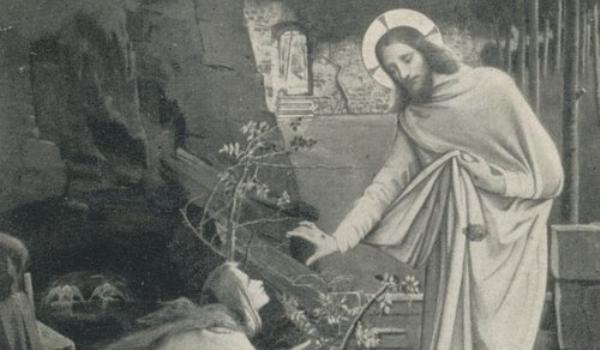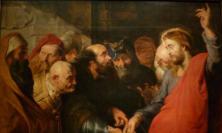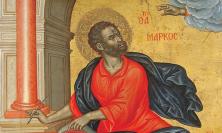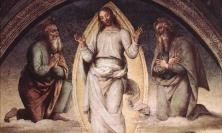Brian Purfield examines the Gospel accounts of the appearances of the risen Jesus. What do they tell us about the disciples’ experience of the Resurrection? What do they tell us about the early Christian communities for whom they were written? What do they tell us about the risen Jesus himself?
The Resurrection of Christ is central to our faith as Christians. Paul proclaims: “If Christ has not been raised, then our preaching is in vain, and your faith is in vain” (1 Corinthians 15:14). From Easter Sunday to Low Sunday, the readings at Mass present the accounts of the appearances of the risen Lord. This article looks at these accounts, in the hope that we may taste something of the experience of the resurrection that the early Christian followers of Christ had.
The Earlier Tradition: St. Paul
Paul offers one of the earliest formulations and says that he himself received it (probably in Damascus about the time of his conversion, three years after the death of Jesus). It is found in 1 Corinthians 15:3-8. Paul lists four essential elements: Jesus died, he was buried, he was raised, and he appeared to Cephas. Inseparable from the claim that Jesus was raised is the fact that he appeared to Simon Peter. This is the basic proclamation of the early Church and is also set out in Luke 24:34. Whether Peter (Cephas) was chronologically the first that Jesus appeared to or not, he is eventually given a symbolic primacy of place as the “rock” or foundation of Christian faith. Paul then lists appearances to others: to the Twelve, to more than 500, to James and all the apostles. He then says that Jesus appeared “last of all to me” (15:8). But he insists that the experience is essentially the same, for there is only one gospel because there is only one revelation.
Paul is the only one to give us a first-hand account of such an experience (Galatians 1:6-24). He does not describe the experience in physical terms. It probably involved some form of seeing or hearing, but Paul emphasises God’s activity. It was God who “was pleased to reveal his Son to me” (Galatians 1:16). He insists that the gospel he proclaims did not come to him through any human mediation but only “through a revelation of Jesus Christ” (1:11-12). It is this revelation that gave him the mission “so that I might proclaim him among the Gentiles” (1:16).
Paul insists throughout his career that he too is an apostle because he too has seen Jesus (1 Corinthians 9:1). The one, unique revelation has produced the one gospel which is the same for all the apostles (Galatians 1:6-9; 2:1-10; 1 Corinthians 15:1-2, 11). Thus, the “appearances” mean at the earliest and most basic level a revelation from God of the presence and significance of Jesus. This divine revelation calls for a response of faith which includes a being sent on mission to proclaim this good news. This is the apostolic foundation of the Church.
Paul’s writings give the basic claim of the early Church that Jesus was raised and appeared to all the apostles from Peter to Paul himself. There seems little doubt that there was a tradition of a number of appearances; yet these were in the past. Where and when did they occur? What happened during them? When did they stop? He does not say. This brings us to the later developments of the tradition, and especially to the stories of the appearances. The Gospel stories try to answer these questions but the answers vary from one Gospel to another.
Later Developments: The Gospels
Here we encounter the pastoral genius of the evangelists. Each wrote for a different audience, and in setting out Jesus’ public ministry each stressed aspects that spoke to the needs and circumstances of that particular audience. Consequently each draws something from the tradition of the appearances of the risen Jesus that ties in clearly with what had been written in the body of his Gospel. Thus the readers (hearers) of the Gospel could see how the Resurrection fitted consistently into the whole presentation of Jesus. Let us look briefly at each of the Gospels in the probable order in which they were written.
Mark
Paul knows that Jesus was buried, yet he never mentions the empty tomb. This first appears in Mark 16:1-8. Because of the brief, almost unfinished nature of that account, early Christians added other endings. The best known is 16:9-20. Thus we speak of two “Marcan” accounts of the Resurrection.
Mark 16:1-8 is basically the story of the empty tomb. A “young man” (an angel-like figure) announces to the women the basic proclamation: “He has been raised” (v.6). There is the promise of his appearance in Galilee to the other disciples and Peter, but it is never described and the story ends with the women leaving the tomb afraid and silent.
Throughout the Gospel Mark stresses how hard it was for Jesus’ followers to believe in him fully because they did not understand that suffering and rejection were an essential part of the identity of the Son of God. Only through suffering will the disciples reach fuller understanding. At Jesus’ passion the male disciples all fail and run away – an experience reflecting fear and shameful weakness. But their pain leads to light. After they have suffered and failed Jesus will appear to them in Galilee (Mark 14:27-28).
The female followers of Jesus, spared the Gethsemane trial where the disciples fell asleep and fled, looked on from afar at the Crucifixion. They too must experience the difficulty of faith; even after they are told of the Resurrection, they do not automatically proclaim Jesus’ victory. Instead they flee in silence and fear (Mark 16:8).
A salutary warning for Christians today? Our faith has come to us from others who have passed on the revelation of what God has done, but the fact that we have accepted that proclamation does not mean we have full Christian faith. Even after the Resurrection we may have to carry the cross and experience suffering and rejection before we reach a real understanding of the Jesus we say we believe in.
Of course Mark does not mean that the women were permanently silent and afraid. The added ending (Mark 16:9-20) recognises this by showing how, not only for the women but for others too, an encounter with the risen Jesus brought about faith. In each case the personal encounter accomplished what a message received from others could not. Faith comes from a personal understanding of the risen Lord.
We also hear how those whom Jesus upbraids for their lack of faith and hardheartedness are entrusted with preaching the gospel to the whole world. These messages are pertinent for us too. Hearing about Jesus never substitutes for a personal experience of him, and neither then nor now was the task of bringing others to Christ entrusted only to the saintly perfect. Mark’s Gospel reminds us that Jesus’ first disciples were, like us, struggling human beings.
Matthew
While drawing on Mark, Matthew is always the more skilled teacher, kinder to readers who do not always see implications. Mark 16:1-8 does not describe appearances of the risen Jesus, Matthew does. In 28:9 he tells of an appearance to the women after they left the tomb – an appearance (echoed in John and Mark 16:9) that may well represent ancient tradition even though it was never part of the official preaching (e.g. as in 1 Corinthians 15).
Even more dramatically, Matthew 27:62-66; 28:4, 11-15 tells us of a plan to frustrate the Resurrection by getting Pilate’s soldiers to guard Jesus’ tomb. One of the tragic aspects in Matthew’s experience, reflected throughout his Gospel, is a hostile relationship between synagogue authorities and Christian believers. At the start, Matthew portrays Herod, the chief priests and scribes plotting to destroy the newly born Messiah (2:3-5, 16-18, 20); but God frustrates their plans. At the end of the Gospel, he portrays the prefect Pilate, the chief priests and the Pharisees plotting against Jesus. Again God intervenes to frustrate their plans. Though the polemical attitude behind this story is not to be imitated, Matthew reminds us that proclaiming the gospel will not be without struggles.
Finally, Matthew describes what Mark only promised: the appearance of Jesus to the disciples (the Eleven) in Galilee. In Matthew’s opening of the public ministry in Galilee (chapters 5-7) Jesus delivers on a mountain a “sermon” giving the essentials of his new teaching about the Kingdom of God. In 10:6-7 Jesus sends his disciples to preach that kingdom “to the lost sheep of the house of Israel.” Then from Galilee the risen Jesus sends his disciples out to teach “all nations” making them disciples by baptising them.
Matthew’s community sees this shift from Jews to Gentiles in the focus of the ministry. Yet Matthew is careful to show that God’s plan for Jesus was consistent from beginning to end. Before his birth, Jesus is proclaimed as Emmanuel (“God with us” – 1:23); his last words are “I am with you all days to the end of time” (28:20).
Luke
Similarly, Luke follows Mark in the basic story of the empty tomb, but goes his own way in the appearances he reports. While Matthew reports an appearance of Jesus in Jerusalem to two women, Luke recounts at length (24:13-35) Jesus’ appearance to two male disciples on the road from Jerusalem to Emmaus. In the Acts of the Apostles (2:42, 46; 20:7, 11), written by Luke as a sequel to his Gospel, he will point to the role of “the breaking of the bread” in Christian community life. He prepares for that in the Emmaus story when the disciples recognise Jesus in the breaking of the bread. This is equally important for believers today since the Eucharistic breaking of the bread constitutes the presence of the risen Jesus – a unique presence different from all others.
Luke then turns to the risen Jesus’ appearance to the Eleven. More than Mark or Matthew, Luke stresses what was already implicit in the empty tomb: the reality of the body of the risen Jesus who was not simply a spirit (23:37-43). Particularly significant is that the risen Jesus teaches the Eleven about his death and resurrection by explaining the Scriptures, “All the things written about me in the Law of Moses, and in the Prophets, and in the Psalms must be fulfilled” (24:44). For Luke the Resurrection fulfils the Scriptures.
The two disciples on the road to Emmaus found their hearts burning when he opened to them the Scriptures. Again Luke’s emphasis is preparing the way for the Church life he will describe in Acts, where Peter, Stephen and Paul begin their preaching by emphasising that the Scriptures anticipate what happened to Jesus (Acts 2:14-21; 7:1-50; 13:16-22).
In Matthew the risen Jesus appears to the Eleven in Galilee. This region is an apt choice from the tradition for Matthew’s purpose. For Matthew, Galilee is the land of the Gentiles (4:15) and after his resurrection Jesus instructs his disciples to go and make disciples of the Gentiles (28:19). Luke, however, highlights Jerusalem as the setting for Jesus’ appearances and his ascension. This is an apt choice from the tradition for his purpose. Luke’s Gospel begins with the appearance of Gabriel to Zechariah in the Jerusalem Temple; it ends with Jesus’ disciples in the Temple blessing God.
At the start of Acts (1:3, 9-12) Jesus ascends into heaven from the Mount of Olives forty days after the resurrection. Yet at the end of the Gospel (24:50-51) Luke has him ascend into heaven from the same region on Easter Sunday night. In this we see Luke’s theological perceptivity. In one sense (dramatically portrayed in the Gospel) Jesus’ return to God was at the end of his earthly career, a career beginning and ending in Jerusalem and thus symbolically lived within the confines of Judaism. In another sense (dramatically portrayed in Acts) Jesus’ return to God begins the life of the Church that starts in Jerusalem (Judaism) and expands to Rome (the Gentile world).
John
John 20, like Luke and Mark 16:9-20, has Jesus’ appearances take place in Jerusalem. John 21 (only superficially linked to John 20), like Matthew and Mark 16:7, has Jesus’ appearance take place in Galilee. Each Chapter, in a different way, is appropriate to John’s thought. John’s Gospel gives us a number of encounters in which each character comes to meet Jesus and reacts to him. This continues in John 20 where one after another, Peter and the Beloved Disciple, Mary Magdalene, the disciples and Thomas encounter the risen Jesus.
The Beloved Disciple is the first to believe. In the tradition (1 Corinthians 15:5; Luke 24:34), Simon Peter was the first of Jesus’ male disciples to see the risen Jesus. John does not deny that but offers his own slant: in the second half of the Gospel the unnamed Beloved Disciple, the one particularly loved by Jesus, is closer than Peter to Jesus. In 20:3-10 Peter and the Beloved Disciple go to the tomb. Neither sees Jesus, but the Beloved Disciple comes to faith without an appearance of the Risen One.
As in Matthew and the added ending of Mark, Mary Magdalene is the first follower to see the risen Jesus. She does not recognise him by sight but when he calls her name, fulfilling the prediction of the Good Shepherd (10:3-5) that he would call by name the sheep that belong to him and they would follow him. Jesus speaks to her of “my Father and your Father” and calls the disciples his “brothers.” Thus to Mary Magdalene Jesus fulfils the promise in John’s Prologue (1:12): “All those who did accept him he empowered to become God’s children.” Consequently Mary Magdalene goes and announces, “I have seen the Lord.” If the Beloved Disciple was the first to believe, Mary Magdalene is the first to proclaim the Risen Lord.
Jesus then appears to the group of disciples (20:19-23), members of the Twelve. As in Genesis 2:7 the Lord God formed a human being from the dust of the earth by breathing into his nostrils the breath of life, so Jesus breathes on the disciples and they receive the Holy Spirit, re-creating them as God’s children with eternal life. This is the birth of the Spirit promised in John 3:5. Throughout the Gospel Jesus refers to himself as the one sent by God; the disciples are now sent to continue his work in the world with his power over evil and sin.
The Gospels mention doubt when Jesus appears to his followers after the Resurrection (Matthew 28:17; Luke 24:37-38; Mark 16:14). John dramatises that doubt in an individual (20:24-29). Paradoxically, the highest confession of faith in the Gospels comes from the lips of “doubting Thomas”: “My Lord and my God.” The Gospel began with the Prologue’s affirmation (1:1), “The Word was God.” Human beings have now come to recognise that.
John 21 moves the setting to Galilee and highlights two scenes related to Simon Peter. A miraculous catch of fish indicated by the risen Jesus is dragged ashore by Peter, a symbol of the missionary role he will have. But the symbolism abruptly shifts as Peter is commissioned to feed Jesus’ sheep. The shift reflects experience: the great missionary thrust in the first generations eventually gave way to pastoral care for those brought to Christ. John’s stress on Jesus as the unique “Good Shepherd” slowed the acceptance of human shepherds in the Johannine community; but when through the symbolism of Peter a shepherding role is authenticated, very Johannine conditions are attached. Peter must love Jesus and the sheep do not become his – they still belong to Jesus.
Yet Jesus’ last word is not about Peter but the Beloved Disciple. He is given no role of authority, but he retains a primacy in being loved, which is more important in this Gospel. It is to the Beloved Disciple that is held open the possibility of being there when Jesus returns. Symbolically that is the final fruit of the Resurrection: a believing community of Christian disciples that remains until the last days.
What do these accounts tell us?
It may appear that the deeper insight of the gospel stories over Paul’s account is to give us a description of the bodilyness of Jesus. Luke describes Jesus walking and talking with the disciples on the road to Emmaus (24:13-27). Both Luke and John, in different ways, describe the risen Lord revealing himself to his disciples in the context of a meal (Luke 24:29-31, 41-43; John 21:10-14). Both give incidents where Jesus calls attention to his hands and feet, pointing out the place of the nails, the evidence of his crucifixion (Luke 24:39f; John 20:20, 25-27). All four gospels record the risen Christ giving explicit instructions to his disciples before his ascension.
It’s easy to conclude that the gospels try to give a picture of what the risen Christ looked like. But that misses the subtle ways the evangelists indicate that the appearances of the risen Lord defy the power of imagination. So each evangelist deliberately portrays the risen Christ as confusingly different and unrecognised. Mary Magdalene thinks Jesus is the gardener; she does not recognise him (John 20:15). Peter and several other disciples, having gone fishing, spot Jesus on the shore but do not realise who he is (John 21:4). The disciples journeying to Emmaus talk with Jesus along the way without knowing who he is, only recognising him in “the breaking of the bread” (Luke 24:16, 30f). On another occasion, the disciples see Jesus but think they are seeing a ghost (Luke 24:37). Each story, in its own way, confirms what Mark said in a more generic, yet more exact, way. Jesus appeared “in another form” to two disciples “walking along the way to the country” (Mark 16:12). However manifest and tangible Jesus’ bodily form is, the evangelists witness to the fact that it is quite different; Jesus is not immediately recognisable.
Another, somewhat mystifying, aspect of Jesus’ bodily appearance is his ability to come and go at will. He appears in the upper room “though the doors were locked” (John 20:19). In breaking the bread, he simply vanishes from the disciples’ sight when they recognise him (Luke 24:30f). He appears apparently from nowhere while the Eleven were at table, only to rebuke them for their unbelief and hardheartedness (Mark 16:14). In the synoptic Gospels, Jesus takes final leave of the disciples (at the ascension) as mysteriously as he had first appeared. Clearly each writer tries to affirm that Jesus’ bodilyness had very different qualities to ours. These qualities made Jesus unrecognisable in the first moments of his appearances and allowed him the freedom to move easily through, in, and out of space and time without restriction.
Addressed by Jesus
Each evangelist affirms that the disciples do come to recognise the risen Lord in these appearances but only as Jesus addresses them in some way. John presents a bewildered Mary Magdalene coming to recognise Jesus precisely as he calls her by name (John 20:15-18). He describes Thomas moving from doubt to faith as Jesus speaks to him, inviting Thomas to recognise him as the crucified one by observing the place of the nails and the wound in his side (John 20:24-28). John says Peter and the disciples come to identify Jesus only after the Lord tells them to lower the nets again to have success after a frustrating night of fishing (John 21:4-7).
Luke stresses the significance of Jesus’ personal address to the disciples as the prelude to their recognising him. In telling the story of two disciples journeying to Emmaus, Luke emphasises that they came to recognise Jesus only as the Lord personally led them through the Scriptures and “broke bread” with them (24:13-35). The synoptic Gospels link the disciples’ recognition of the risen Lord to his “giving them a commission,” again a very personal word touching on their responsibilities to continue his ministry. The gospel stories show that the disciples’ ability to identify the risen Lord depends not only on Jesus’ appearance before them, but also on his speaking a personal word to them.
Conclusion
The gospel accounts carefully emphasise the final effect of the risen Lord’s appearances and words. His appearances lead the disciples to a richer and deeper faith in who he is. They express this deeper faith in Jesus by giving him, still recognised as the crucified one, a new name. Individually and together, they rejoice: “We have seen the Lord” (John 20:18, 25; 21:7), while Thomas even more explicitly confesses: “My Lord and my God” (John 20:28). Like Paul writing to Philippi, the evangelists seek to highlight the fact that the disciples, as they see and hear the risen Christ, give Jesus the “name that is above every name” (Philippians 2:9): Jesus is one with God; he is filled with God’s life: “Jesus is Lord.”
Brian Purfield is Head of Theological Education at Mount Street Jesuit Centre






